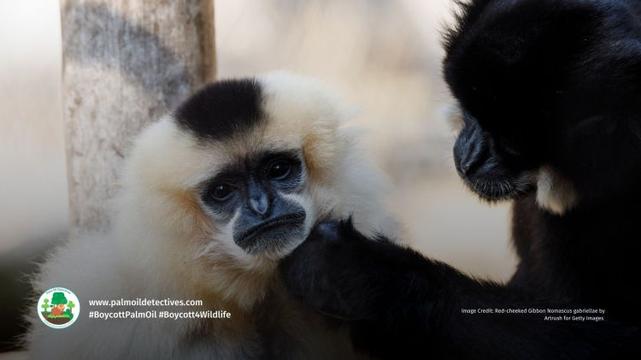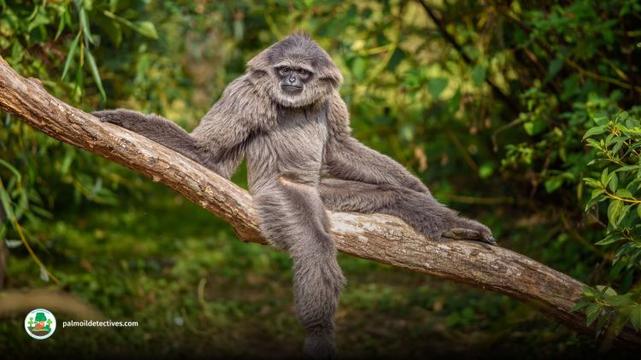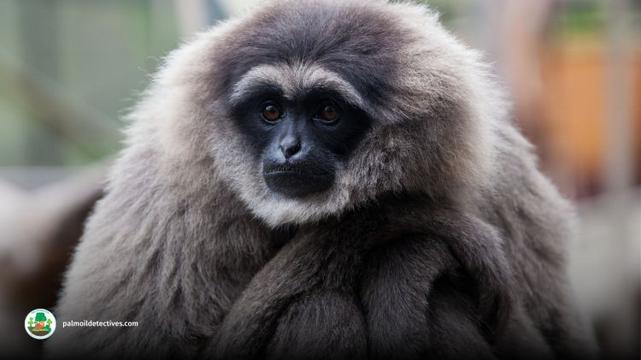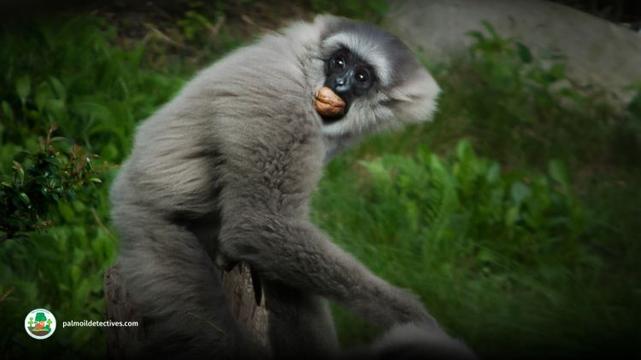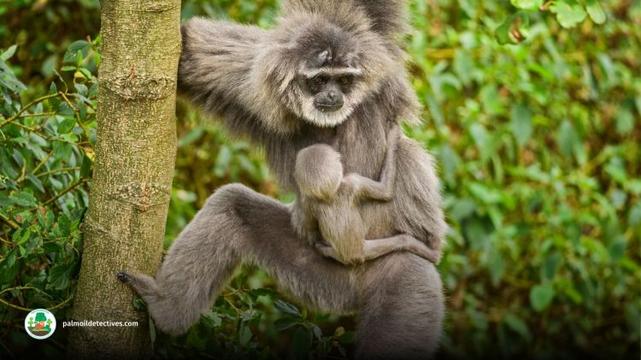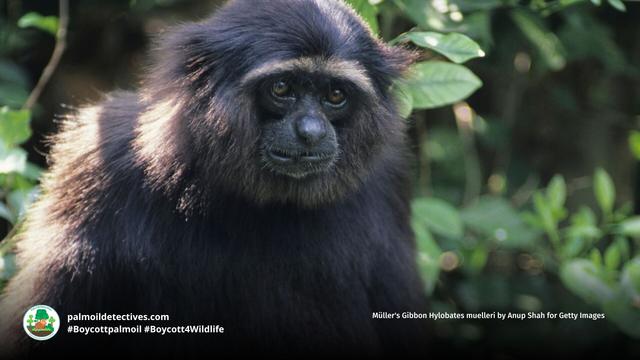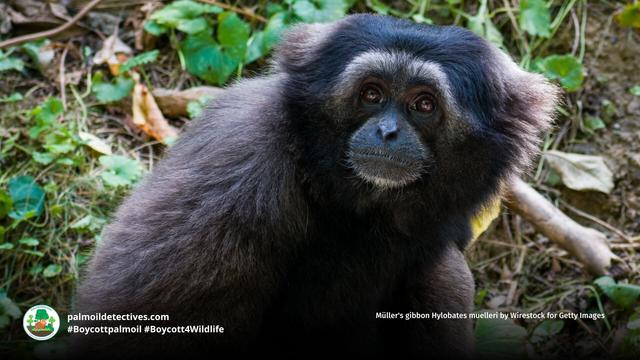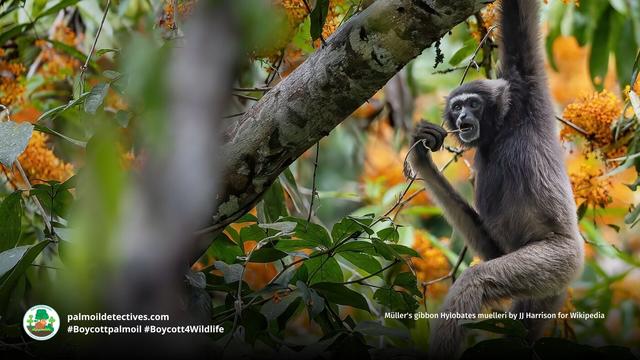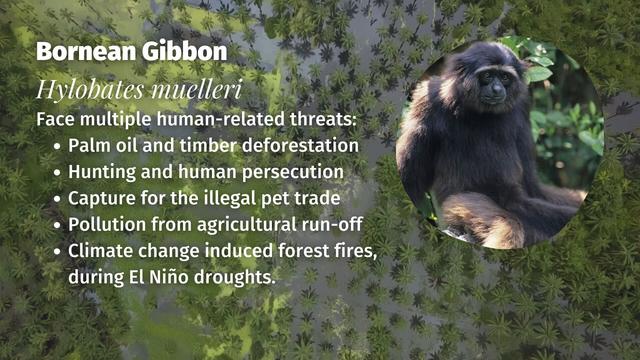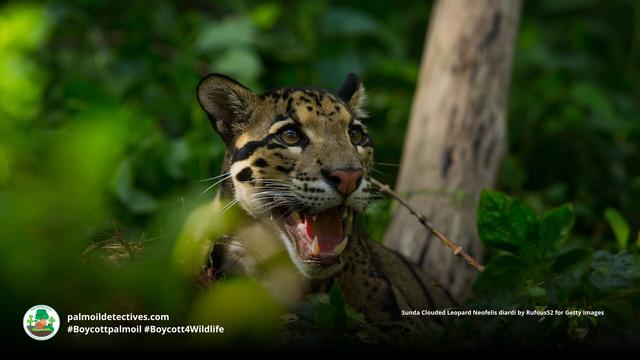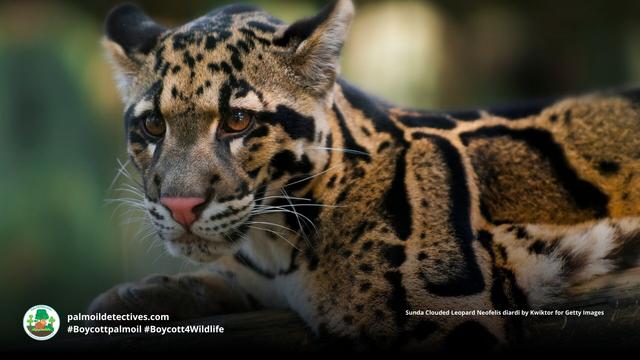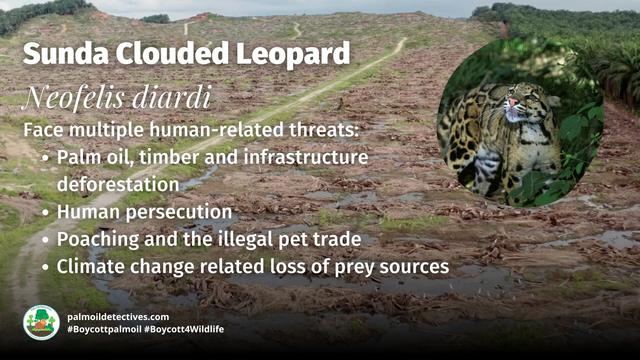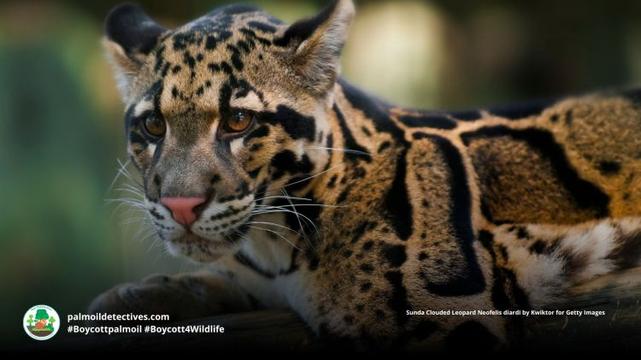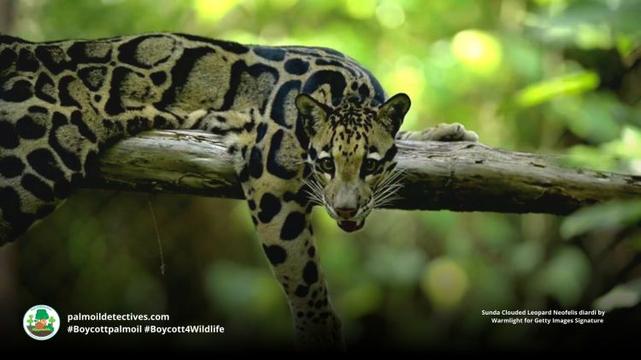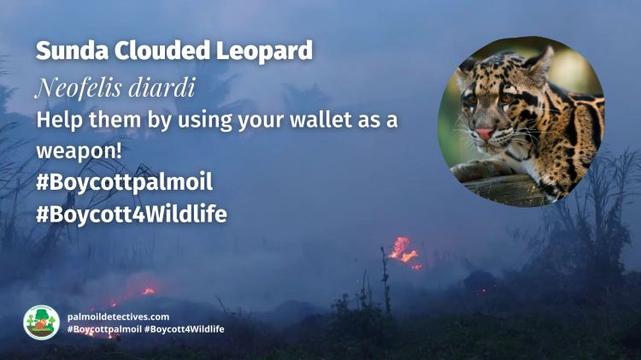Family-minded with a long-limbed and a vivacious energy ✨🎇 Black-crested #gibbons 🐒🐵are #endangered in #China 🇨🇳and #Vietnam 🇻🇳 due to #poaching and the bushmeat trade and #deforestation. Help them survive #Boycott4Wildlife 🌴☠️🚫 @palmoildetect
https://palmoildetectives.com/2021/01/29/black-crested-gibbon-nomascus-concolor/?utm_source=mastodon&utm_medium=Palm+Oil+Detectives&utm_campaign=publer
#gibbons
Southern White-cheeked #Gibbons 🐒🐵 sing together in regional dialects 🪇🎶🎷 and live in #Cambodia #Laos #Vietnam. They’re critically #endangered on due to #rubber #palmoil #deforestation and hunting. Help them and #BoycottPalmOil 🌴🚫 @palmoildetect https://palmoildetectives.com/2021/01/29/southern-white-cheeked-gibbon-nomascus-siki/?utm_source=mastodon&utm_medium=Palm+Oil+Detectives&utm_campaign=publer
Gibbon song may be music to the ears of human language students
#Gibbons and humans have more in common than might immediately seem apparent. Among many behavioural traits shared by our two species is singing. Not just that – the songs of gibbons have the potential to teach us about the origin of our own human capacities. Many are threatened by #palmoil #deforestation 🌳✨ #Boycottpalmoil #Boycott4Wildlife
🎶 🐵 #Gibbons are musical maestros. Their songs unlock the secrets of human language. Let’s protect them and their symphony. Many are threatened by #palmoil #deforestation 🌳✨ #Boycottpalmoil #Boycott4Wildlife @palmoildetect https://palmoildetectives.com/2021/02/21/gibbon-song-may-be-music-to-the-ears-of-human-language-students/
Share to BlueSky Share to TwitterBackground
The Japanese research emerges from a framework in evolutionary studies (with papers such as this one, this one and this one and here) in which cross-species comparison permits speculation on the origin of human capacities.
Among the features of gibbon behaviour that correspond to humans are:
- monogamy, and the “nuclear family”
- voice development in adolescence, especially in the male
- the capacity for upright posture
- vocal duetting in which male and female have acoustically complementary ranges, the adult male’s voice being lower than the female’s.
Walking instruments
As Martin Braun reminds us, all mammals are walking wind instruments. Research in acoustic communication addresses several key questions, among them:
- how sound is produced anatomically
- whether it is learned or stereotypical (the aspect of acquisition)
- what social or intra-specific purpose it serves
- the nature of the neural networks responsible for its perception and production
Back to the study
The authors of the AJPA study are interested in all of these interrelated factors. But their paper focuses in particular on the way the distinct acoustic signal (or sound) of female gibbons is produced and what this tells us about the feedback loop between sound-production and self-perception in the subject.
At the core of the AJPA study is a series of experiments – first modelled on a computer and then carried out in the laboratory – designed to test a rather complex theory: that female gibbons have the ability to modify the configuration of their vocal tracts in order to amplify signals in a specific range.
In this range, their voices are capable of extraordinarily effective exploitation of limited anatomical means.
In other words, humans and gibbons have both evolved neural control over their respiratory tracts. It is therefore what the brain achieves that allows this level of performance: the vocal tracts themselves are not especially well-suited to their task!
The rowdy, singing gibbon gang – all of them are endangered by deforestation
Pileated Gibbon Hylobates pileatus
by Palm Oil DetectivesWestern Hoolock Gibbon Hoolock hoolock
by Palm Oil DetectivesEastern Hoolock Gibbon Hoolock leuconedys
by Palm Oil DetectivesSkywalker Hoolock Gibbon Hoolock tianxing
by Palm Oil DetectivesKloss’s Gibbon Hylobates klossii
by Palm Oil DetectivesBornean White-bearded Gibbon Hylobates albibarbis
by Palm Oil DetectivesMüller’s gibbon Hylobates muelleri
by Palm Oil DetectivesSilvery Gibbon Hylobates moloch
by Palm Oil DetectivesAbbott’s Gray Gibbon Hylobates abbotti
by Palm Oil Detectives by Palm Oil DetectivesNorthern Gray Gibbon Hylobates funereus
by Palm Oil DetectivesTonkin Black Crested Gibbon Nomascus concolor ssp. concolor
by Palm Oil DetectivesRed-cheeked Gibbon Nomascus gabriellae
by Palm Oil DetectivesSouthern White-cheeked Gibbon Nomascus siki
by Palm Oil DetectivesNorthern Yellow-cheeked Crested Gibbon Nomascus annamensis
by Palm Oil DetectivesNorthern White-cheeked Gibbon Nomascus leucogenys
by Palm Oil DetectivesCao-vit Gibbon Nomascus nasutus
by Palm Oil DetectivesBlack Crested Gibbon Nomascus concolor
by Palm Oil DetectivesHainan Gibbon Nomascus hainanus
by Palm Oil Detectives by Palm Oil DetectivesWhere musical instruments such as flutes and trumpets have relatively fixed properties of bore, length and shape, the respiratory tracts of mammals are capable of modification in a variety of ways, including:
- lowering of the larynx
- adaptation of the posture of the larynx
- lifting of the soft palate
- nasalisation
- adaptation of the shape of the mouth
- position and posture of the tongue, and
- adaptation of the opening of the lips.
Significantly, all of these are more-or-less involved in the production of the variety of sounds on which language tends to depend.
But the aim of the Japanese research was to explore whether gibbons “tune” the shaping of their throats, mouths and lips to the frequencies generated by their vocal folds.
It’s a gas
The researchers used helium in their experiments. The use of helium as the medium in which the gibbon vocalised is thus a means of ascertaining how the subject responded to the effect – which in humans tends to shift the resonant frequencies of the voice towards “squeaky” higher “formants” (the acoustic response within an instrument – or voice – that defines the quality of sound, or timbre).
As in humans, gibbon vocalisation in the helium condition resulted in a shift of resonance to higher formants. Significantly, this was more pronounced in the higher range of the gibbon calls. This higher range marks their characteristic achievement of high-intensity vocal production able to carry over distance.
If this suggests parallels with human singing, it’s worth spelling out that all female gibbons achieve this remarkable capacity for self-amplification instinctively. Gibbon song is not learned – the ability is hard-wired.
By contrast, the opera singers to which the study’s title refers achieve a parallel ability only after careful training.
To hear the more effortlessly competent performance of a variety of gibbon species, a visit to Thomas Geissmann’s impressive gibbon research website is warmly recommended.
What comes next?
The research done by Nishimura and team opens up some fascinating avenues for follow-up studies, including:
- replication with human subjects, both expert singers and non-singers
- replication with other primate species (this is, apparently, underway)
- play-back of the helium-condition calls to conspecifics (as well as being great vocalisers, gibbons are sophisticated listeners. The purpose of studying this area further would be to see whether other gibbons recognised in any way the humanly distorted recordings as gibbon-song)
One of the most interesting things about gibbon/human voice comparison is how easy it is for suitably uninhibited humans to elicit vocal responses from gibbons by imitating their song.
This doesn’t work for many species – try it out on most dogs, cats, horses, chimpanzees and you will encounter failure … or worse. https://www.youtube.com/embed/iAmx_XdQky8?wmode=transparent&start=0
But gibbons safely contained behind barriers are remarkably tolerant of human attempts at their song. I have personal experience of this at Twycross Zoo in the UK and Perth Zoo in Australia. My youngest son, when a boy treble, was able to imitate female gibbon calls with considerable accuracy.
This seems consistent with his ability to perform the high-lying solos in works such as Allegri’s Miserere that require precisely the acoustic control explored in this study, and whose range conforms to that in which the gibbons sing most effectively.
So some investigation of similarities with the voices of pre-adolescents in both species might also be of interest, especially with a view to tracing the means by which the ability is acquired in gibbons.
While the gibbon call is clearly acquired as a means of high-intensity transmission that permits communication across distance in dense rainforest vegetation, I have heard gibbons “rehearsing” precisely the same songs quietly: a solitary female in an isolated pen at Twycross Zoo in the UK; and two juveniles in quarantine under the supervision of their curator at Perth Zoo in Australia.
This adds additional dimensions of the roles of energy and pragmatics to the findings of this study: it illustrates that, while gibbons are capable, much like human sopranos, of ear-splitting volume, they can also achieve the same calls quietly.
In “engineering” terms this means they can control breath-flow alongside the “tuning” effects already described.
Investigation of these features would be of interest in order to tease out implications of this study for the evolution of human language.
Nicholas Bannan, Professor in Music Education, University of Western Australia. This article is republished from The Conversation under a Creative Commons license. Read the original article.
#animalBehaviour #AnimalBiodiversityNews #animals #Boycott4wildlife #BoycottPalmOil #deforestation #Gibbon #Gibbons #language #monkey #palmoil #Primate #songs
Silvery Gibbon Hylobates moloch
Silvery Gibbon Hylobates moloch
Red List Status: Endangered
Locations: Indonesia (island of Java, including provinces of Banten, West Java, and Central Java as far east as the Dieng Mountains)
The Silvery #Gibbon 🩶🐒🐵 of genus ‘Hylobates’ meaning ‘Forest Walker’. They sing to each other in ‘local’ accents and do thrilling acrobatics 🤸♂️ They are #endangered, help them to survive! #BoycottPalmOil #Boycott4Wildlife 🌴🔥⛔️ @palmoildetect https://palmoildetectives.com/2021/02/06/silvery-gibbon-hylobates-moloch/
Share to BlueSky Share to TwitterThe Silvery Gibbon belongs to the genus Hylobates. The word Hylobates means ‘Forest Walker’ in Greek. The gibbons in this genus are known for the white circle of fur around their faces. They are known to communicate in species-specific song when defining territory or attracting mates. They sing in regional accents to each other, have long swinging arms, inquisitive natures and superior acrobatic skills, they spend most of their lives high up in the tree-tops.
Appearance & Behaviour
Silvery gibbons are small apes, their bodies draped in long, silvery-grey fur with a dark grey or black cap on their heads and a distinctive fringe of white or light grey around their dark faces. Adults typically weigh around 6 kilograms, with males and females similar in size. Their arms are exceptionally long, spanning twice their body length, allowing them to brachiate—swing hand over hand—through the treetops with remarkable speed and agility. Unlike many other gibbon species, silvery gibbons do not sing duets; instead, it is the females who dominate the morning chorus with loud, haunting calls that echo through the forest. These family groups, usually consisting of a monogamous pair and their offspring, move together through the canopy, their movements fluid and almost effortless.
Threats
Palm oil and agricultural deforestation
Silvery gibbons face severe pressure from the ongoing loss of their forest habitat. In Java, particularly in Banten Province, deforestation is accelerating at a high rate. The conversion of forests to agricultural land, including palm oil plantations and other crops, leaves behind only isolated fragments of habitat. This fragmentation forces gibbons into ever-smaller territories, increasing stress and competition for resources. The once-continuous canopy that silvery gibbons depend on is being replaced by agricultural fields, making survival increasingly difficult for these arboreal primates.
Illegal pet trade, illegal poaching and hunting
Silvery gibbons are targeted by hunters for both meat and the illegal pet trade. Poachers often kill adult gibbons to capture infants, who are then sold as pets in markets throughout Indonesia. This practice not only removes individuals from the wild but also disrupts family groups and weakens the social structure essential for gibbon survival. The illegal pet trade remains a persistent and devastating threat, driven by demand for exotic animals and compounded by the ongoing destruction of their natural habitat.
Timber logging and habitat fragmentation
Logging operations further degrade and fragment the remaining forest habitat of silvery gibbons. Roads and clearings cut through the forest, severing the vital canopy connections that gibbons rely on for movement and social interaction. Fragmentation isolates populations, reducing genetic diversity and making them more vulnerable to disease and environmental change. In many areas, only small, isolated groups of gibbons remain, cut off from neighbouring populations by cleared land.
Climate change
Shifting rainfall patterns and rising temperatures threaten to alter the delicate balance of Indonesia’s forests. Changes in fruiting and flowering times can disrupt the silvery gibbon’s food supply, while extreme weather events destroy habitat and isolate populations even further. The silvery gibbon’s world is becoming hotter, drier, and less predictable, with the forests they depend on shrinking year by year.
Diet
Silvery gibbons are primarily frugivorous, with fruit making up about 61% of their diet and leaves accounting for another 38%. They also consume flowers and, to a lesser extent, insects. The silvery gibbon’s foraging is a daily journey through the treetops, as they search for scattered fruit-bearing trees. Their home ranges average between 17 and 60 hectares, and several families may share overlapping territories, especially where fruit is abundant. The rhythm of their feeding is woven into the life of the forest, as they play a vital role in seed dispersal and the regeneration of their ecosystem.
Mating & Reproduction
The Silvery Gibbon is considered Endangered based on a suspected population reduction of 50% or more over the course of three generations (2001-2015, 2016-2030, 2031-2045). This ongoing decline is due to the combined threats of forest habitat loss and hunting for subsistence purposes, in addition to supplying the pet trade.
IUCN Red List
Silvery gibbons are monogamous, forming lifelong pair bonds. There is no set breeding season, and females give birth to a single infant after a gestation period of about seven to eight months. The mother carries her baby close for the first year, nursing and protecting it as the family group moves through the forest. Weaning occurs at around 18 months, and offspring remain with their parents until they reach maturity at about eight years of age, when they leave to form their own families. The family unit is tight-knit, with both parents sharing in the care of their young and strong emotional bonds that are essential for survival in a changing world.
Geographic Range
Silvery gibbons are endemic to the island of Java, Indonesia, with their range primarily in the (still forested) western regions of Banten and West Java, and extending into parts of Central Java as far east as the Dieng Mountains. They inhabit lowland and lower montane rainforests up to 2,400 metres above sea level, though they are most commonly found below 1,600 metres. Their historical range has contracted dramatically due to deforestation and human infrastructure development, and they are now restricted to fragmented forest patches. The sounds of the silvery gibbon—once a common feature of Java’s forests—are now tragically heard in very few places.
FAQs
How many silvery gibbons are left?
Estimates suggest that fewer than 2,500 mature silvery gibbons remain in the wild, with populations continuing to decline due to habitat loss, fragmentation, and the illegal pet trade. In some areas, fewer than 2,000 individuals are considered genetically viable for the continuation of the species. The silvery gibbon’s future is precarious, and urgent action is needed to prevent their extinction.
What are the characteristics of the silvery gibbon?
Silvery gibbons are small, slender apes with long, silvery-grey fur and a dark cap on their heads. They lack a tail, and their arms are exceptionally long—up to twice their body length—allowing them to brachiate through the forest canopy with remarkable speed and grace. Adults typically weigh between 6 and 8 kilograms, with males slightly larger than females. Silvery gibbons are strictly arboreal, rarely descending to the forest floor, and live in small, monogamous family groups. The female leads the morning chorus with haunting, resonant calls that can be heard for up to a kilometre.
Is a silvery gibbon a monkey?
A silvery gibbon is not a monkey, but a lesser ape. The primary difference between a lesser ape (like a gibbon) and a monkey is that apes, including lesser apes, do not have tails, while most monkeys do. Additionally, apes are generally larger and have broader chests, while monkeys tend to be smaller and have narrower chests. Apes also have shoulder joints that allow for brachiation—swinging through trees—and some species exhibit higher intelligence and tool use. Lesser apes, such as gibbons and siamangs, are smaller than the great apes (chimpanzees, gorillas, orangutans, and humans) but share these key anatomical and behavioural traits. In contrast, most monkeys have tails, which they use for balance, and are more adapted to running along branches rather than swinging through the trees. While monkeys are intelligent, apes generally exhibit more complex cognitive abilities and social behaviours.
Why will the silvery gibbon become extinct in the next decade?
The silvery gibbon faces multiple, compounding threats that make extinction within the next decade a real possibility. Habitat loss due to deforestation has reduced their forest home to less than 4% of its original extent. Fragmentation isolates populations, making them more vulnerable to disease and genetic decline. The illegal pet trade continues to remove individuals from the wild, and climate change is altering the availability of food and water. Without urgent, large-scale intervention, the silvery gibbon is likely to disappear from much of its remaining range.
Are gibbon monkeys aggressive?
Gibbons, including silvery gibbons, are not monkeys but lesser apes. In their natural environment, silvery gibbons are highly territorial and will defend their home range with vocalisations and, if necessary, physical displays. Males and females both play a role in defending their territory, with the female’s morning calls and the male’s aggressive responses to intruders. Within the family group, silvery gibbons are generally peaceful and nurturing, with strong social bonds between parents and offspring. In captivity, gibbons can show aggression during introductions or when resources are contested, but this is not typical of their behaviour in the wild.
Are silvery gibbons Endangered?
Yes, the silvery gibbon is classified as Endangered on the Red List of Threatened Species. Their population is estimated at fewer than 2,500 mature individuals and is declining due to habitat loss, fragmentation, and the illegal pet trade. The silvery gibbon’s survival is at risk, and their future depends on the protection of remaining forest habitat and the reduction of human-induced threats
Take Action!
Use your wallet as a weapon and #BoycottPalmOil #Boycott4Wildlife. Support indigenous-led conservation and agroecology. Reject products linked to deforestation, mining, and the illegal wildlife trade. Adopt a #vegan lifestyle and #BoycottMeat to protect wild and farmed animals alike. Every choice matters—stand with the silvery gibbon.
Further Information
Kim, S., Lappan, S., & Choe, J. C. (2010). Diet and ranging behavior of the endangered Javan gibbon (Hylobates moloch) in a submontane tropical rainforest. American Journal of Primatology, 72(10), 991–1000. https://doi.org/10.1002/ajp.20893
Nijman, V. 2020. Hylobates moloch. The IUCN Red List of Threatened Species 2020: e.T10550A17966495. https://dx.doi.org/10.2305/IUCN.UK.2020-2.RLTS.T10550A17966495.en. Downloaded on 06 February 2021.
Reyes, K. R., Patel, U. A., Nunn, C. L., & Samson, D. R. (2021). Gibbon sleep quantified: The influence of lunar phase and meteorological variables on activity in Hylobates moloch and Hylobates pileatus. Primates, 62, 749–759. https://pubmed.ncbi.nlm.nih.gov/34052907/
Silvery Gibbon Hylobates moloch
How can I help the #Boycott4Wildlife?
Take Action in Five Ways
1. Join the #Boycott4Wildlife on social media and subscribe to stay in the loop: Share posts from this website to your own network on Twitter, Mastadon, Instagram, Facebook and Youtube using the hashtags #Boycottpalmoil #Boycott4Wildlife.
2. Contribute stories: Academics, conservationists, scientists, indigenous rights advocates and animal rights advocates working to expose the corruption of the palm oil industry or to save animals can contribute stories to the website.
Mel Lumby: Dedicated Devotee to Borneo’s Living Beings
Anthropologist and Author Dr Sophie Chao
Health Physician Dr Evan Allen
The World’s Most Loved Cup: A Social, Ethical & Environmental History of Coffee by Aviary Doert
How do we stop the world’s ecosystems from going into a death spiral? A #SteadyState Economy
3. Supermarket sleuthing: Next time you’re in the supermarket, take photos of products containing palm oil. Share these to social media along with the hashtags to call out the greenwashing and ecocide of the brands who use palm oil. You can also take photos of palm oil free products and congratulate brands when they go palm oil free.
https://twitter.com/CuriousApe4/status/1526136783557529600?s=20
https://twitter.com/PhillDixon1/status/1749010345555788144?s=20
https://twitter.com/mugabe139/status/1678027567977078784?s=20
4. Take to the streets: Get in touch with Palm Oil Detectives to find out more.
5. Donate: Make a one-off or monthly donation to Palm Oil Detectives as a way of saying thank you and to help pay for ongoing running costs of the website and social media campaigns. Donate here
Pledge your support#Ape #apes #BanPrimateExperiments #Boycott4wildlife #BoycottMeat #BoycottPalmOil #endangered #EndangeredSpecies #ForgottenAnimals #forgottenanimal #frugivore #Gibbon #Gibbons #illegalPetTrade #Indonesia #Indonesian #infrastructure #Java #Javan #Mammal #palmoil #Primate #primates #roads #SilveryGibbonHylobatesMoloch #timber #vegan #wildlifetrade
#TheGesualdoSix
#EnglishMotets (2018) on #Vinyl
"We are delighted to present our debut album, English Motets (2018) on vinyl! This limited edition LP features tracks from our first recording, showcasing some of the most beautiful music from the #Renaissance in England..."
https://www.thegesualdosix.co.uk/shop/english-motets-2018-vinyl/
iTunes streaming
https://music.apple.com/ca/album/english-motets-from-dunstaple-to-gibbons/1706460055
#Tallis #Byrd #Tomkins #Cornysh #Sheppard #Dunstable #Gibbons #Taverner
DYK Müller's #Gibbons recognise each other's calls with 95% accuracy? 🎵🪇📢This reflects deep social bonds and intelligence 🐵🐒🤎 #Endangered by #palmoil and hunting, help them survive! 🌴🩸🔥🚫 #BoycottPalmOil for them #Boycott4Wildlife @palmoildetect.bsky.social https://palmoildetectives.com/2021/02/06/bornean-gibbon-hylobates-muelleri/?utm_source=mastodon&utm_medium=Palm+Oil+Detectives&utm_campaign=publer
Sunda Clouded #leopards are agile ambush #predators 🐆 of #gibbons, wild #pigs and mouse deer in #Borneo and #Sumatra. #Palmoil deforestation is a huge threat to these #BigCats. Help them when you #Boycottpalmoil 🌴🔥💀🚫#Boycott4Wildlife @palmoildetect https://wp.me/pcFhgU-anN?utm_source=mastodon&utm_medium=Palm+Oil+Detectives&utm_campaign=publer
Right now, sacred music from #Gothenburg: #Parsons #Gibbons #Poulenc #Lidholm #Bach and more https://www.worldconcerthall.com/en/schedule/sacred_music_from_gothenburg_parsons_gibbons_poulenc_lidholm_bach_and_more/86901/ #wch
In 15 minutes, sacred music from #Gothenburg: #Parsons #Gibbons #Poulenc #Lidholm #Bach and more https://www.worldconcerthall.com/en/schedule/sacred_music_from_gothenburg_parsons_gibbons_poulenc_lidholm_bach_and_more/86901/ #wch
The lovable Gibbon Family that will bring a smile to anybody's face.
https://t.co/C6YKTH5RSI
#gibbons #whitehandedgibbon #gibbon #zoodepalmyre https://t.co/QV4sblFDto
— SloggerVlogger (@SloggerVlogger)
Apr 16, 2025
April 16, 2025 at 10:01AM
via Twitter https://twitter.com/SloggerVlogger
The lovable Gibbon Family that will bring a smile to anybody's face.
https://t.co/C6YKTH5RSI
#gibbons #whitehandedgibbon #gibbon #zoodepalmyre https://t.co/QV4sblFDto
— SloggerVlogger (@SloggerVlogger)
Apr 16, 2025
April 16, 2025 at 10:01AM
via Twitter https://twitter.com/SloggerVlogger
#Hosanna to the Son of David • by Orlando #Gibbons • performed by @TheGesualdoSix and the Sixth Form Choristers of #TruroCathedral Choir • Directed by #OwainPark • Images by LLE Photography • With thanks to Angel
Hosanna to the son of David. Blessed be he that cometh in the name of the Lord. Blessed be the king of Israel. Blessed be the kingdom that cometh in the name of the Lord. Peace in heaven and glory in the highest places. Hosanna in the highest heavens.
Vehicles under water in Gibbons parking lot as London sees one of its wettest April days ever
A day-long rain event dumped nearly a months-worth of precipitation on the city in roughly 24 hours, resulting in one of the wettest April days on record, Environment Canada said.
#weather #flood #parking #London #Gibbons #News
https://www.cbc.ca/news/canada/london/vehicles-under-water-in-gibbons-parking-lot-as-london-sees-one-of-its-wettest-april-days-ever-1.7501364?cmp=rss
Sunda Clouded #leopards are agile ambush #predators 🐆 of #gibbons, wild #pigs and mouse deer in #Borneo and #Sumatra. #Palmoil deforestation is a huge threat to these #BigCats. Help them when you #Boycottpalmoil 🌴🔥💀🚫#Boycott4Wildlife @palmoildetectives https://wp.me/pcFhgU-anN
Sunda Clouded Leopard Neofelis diardi
Sunda Clouded Leopard Neofelis diardi
IUCN Status: Vulnerable
Location: Brunei Darussalam; Indonesia (Sumatera, Kalimantan); Malaysia (Sarawak, Sabah)
Gliding through the rainforest canopy like a phantom predator, the Sunda Clouded Leopard moves with unmatched grace, making them one of the least understood big cats in the world. Their spectacularly patterned coat, the longest canines relative to skull size of any feline, and astonishing agility in trees set these big cats apart as a truly unique species. Yet, despite these remarkable adaptations, these mysterious carnivores are now rapidly vanishing from the wild due to human-related threats.
Massive infrastructure projects, industrial-scale palm oil plantations, and poaching for the illegal wildlife trade have decimated their populations. Once thought to be a subspecies of the mainland clouded leopard, genetic studies in 2006 confirmed that they are a distinct species, found only in Borneo and Sumatra. Today, they are among the most threatened felines in the world, teetering on the edge of an uncertain future. Take action for them every time you shop and #BoycottPalmOil #Boycott4Wildlife
Sunda Clouded #leopards are agile ambush #predators 🐆 of #gibbons, wild #pigs and mouse deer in #Borneo and #Sumatra. #Palmoil deforestation is a huge threat to these #BigCats. Help them when you #Boycottpalmoil 🌴🔥💀🚫#Boycott4Wildlife @palmoildetect https://wp.me/pcFhgU-anN
Share to BlueSky Share to TwitterSleek and elegant wild #Cats 🐱🐆 of #Indonesia 🇮🇩 and #Malaysia 🇲🇾 Sunda Clouded #Leopards are #vulnerable due to #PalmOil #Deforestation and #poaching Help them when you 🌴🩸🔥⛔️ #Boycottpalmoil #Boycott4Wildlife @palmoildetect https://wp.me/pcFhgU-anN
Share to BlueSky Share to TwitterAppearance & Behaviour
Sunda Clouded Leopards are expert climbers, possessing a long, thick tail (equal to their body length) for balance, rotating ankle joints that allow them to descend trees headfirst, and razor-sharp retractable claws for gripping bark. Their bodies are smaller and more compact than mainland clouded leopards, making them highly agile ambush predators.
They are solitary and nocturnal, moving silently through the forest to hunt primates, deer, and birds. Unlike most big cats, they purr rather than roar and rely on their extraordinarily developed senses to detect prey. Though they spend time on the forest floor, they are one of the most arboreal of all felines, capable of jumping several metres between branches.
Threats
1. Deforestation for infrastructure, timber and palm oil
- More than 50% of Borneo’s forests and two-thirds of Sumatra’s forests have been destroyed, mainly for palm oil plantations and logging.
- Mega infrastructure projects, including the Pan Borneo Highway, Trans-Sumatra Highway, and Indonesia’s new capital (Nusantara), are further severing vital forest corridors.
- Illegal logging and forest conversion continue to reduce already fragmented populations, leaving them trapped in isolated forest patches.
2. Poaching and the Illegal Wildlife Trade
Highly valued for their skins, bones, and meat, they are frequently trapped in snares. Between 2011 and 2019, at least 30 individuals were seized in the illegal trade, with live animals smuggled internationally. The rise in commercial wildlife markets has put additional pressure on an already declining population.
3. Loss of Prey and Ecosystem Disruptions
Overhunting of deer, wild boar, and primates is drastically reducing their food supply. A 2024 study revealed that mesopredator release—where smaller carnivores like Sunda Leopard Cats increase in number—may be negatively impacting the number of clouded leopards.
4. Human-Wildlife Conflict and Retaliatory Killings
Farmers kill clouded leopards when they prey on livestock. With deforestation pushing them into human settlements, conflict is increasing.
5. Climate Change and Forest Fires
Longer dry seasons and extreme weather due to climate change are making rainforest habitats unstable and food sources scarcer. Fires, caused by land clearing for palm oil plantations, are destroying crucial remaining habitat.
Geographic Range
The Sunda Clouded Leopard (Neofelis diardi) is found only on the Southeast Asian islands of Borneo and Sumatra. Known locally as rimau-dahan (“tree tiger” in Malay) and entulu in Sarawak, these elusive big cats thrive in dense rainforests, where their exceptional climbing skills and camouflage allow them to hunt undetected. They are particularly dependent on lowland primary forests but have been increasingly pushed into montane and secondary forests due to rampant deforestation.
Key Habitats:
- Sumatra – Leuser Ecosystem, Kerinci Seblat National Park, Bukit Barisan Selatan National Park
- Borneo – Kalimantan (Indonesian Borneo), Sabah and Sarawak (Malaysian Borneo), Brunei Darussalam
- Heart of Borneo Landscape – This transboundary rainforest, spanning Brunei, Malaysian Borneo, and Indonesian Kalimantan, serves as one of the last strongholds for the species.
Diet
Sunda Clouded Leopards are apex rainforest predators, feeding on:
- Primates – Gibbons, macaques, langurs
- Ungulates – Mouse deer, muntjac, young bearded pigs
- Birds, rodents, and reptiles
- Occasionally livestock in fragmented forest areas
Their hunting strategy involves stealth and ambush, using their powerful jaws and canines to deliver a fatal bite to the neck. As their habitat shrinks, they are increasingly forced into human settlements, where they are often shot in retaliation.
Mating and Reproduction
Little is known about their breeding behaviour, however:
- They reach sexual maturity at around two years old.
- Gestation lasts 85–95 days, producing 1–5 cubs (typically 2).
- Cubs remain hidden in dense vegetation for the first five months.
- Mothers raise cubs alone, teaching them to hunt before they become independent.
- Their slow reproductive rate, combined with habitat destruction, makes population recovery extremely difficult.
FAQs
Are Sunda Clouded Leopards dangerous to humans?
No. Sunda Clouded Leopards are extremely elusive and prefer to avoid human contact. They only venture into human areas when forced by habitat loss.
How are they different from mainland Clouded Leopards?
Sunda Clouded Leopards (Neofelis diardi) were originally thought to be the same species as the Indochinese Clouded Leopard (Neofelis nebulosa), but genetic studies in 2006 confirmed that they are separate species.
• Genetic divergence: The two species diverged between 2 million and 900,000 years ago, likely when rising sea levels isolated Borneo and Sumatra from the mainland.
• Physical differences: Sunda Clouded Leopards have darker fur, smaller cloud markings, and a more robust build, whereas Indochinese Clouded Leopards are lighter in colour with larger, more defined markings.
• Habitat preferences: Sunda Clouded Leopards rarely descend to the forest floor, whereas Indochinese Clouded Leopards hunt both in trees and on the ground.
Why are they called “Tree Tigers”?
The Malay name rimau-dahan means “tree tiger”, as they are among the best tree-climbing predators in the world. This name comes from their incredible climbing skills and their resemblance to big cats like tigers. Their large paws, long tail, and flexible ankles make them exceptional tree climbers, often leaping between branches or ambushing prey from above.
Are Sunda Clouded Leopards extinct anywhere?
They were once found on Java, but are now extinct there.
How many Sunda Clouded Leopards are left?
Estimates suggest there are fewer than 10,000 mature individuals, but deforestation and poaching are causing rapid declines. Exact numbers are hard to determine due to their elusive nature.
Take Action!
Every time you shop, choose 100% palm oil-free products to avoid contributing to deforestation. #BoycottPalmOil #Boycott4Wildlife
- Boycott palm oil and products that contribute to rainforest destruction.
- Support conservation efforts protecting Borneo and Sumatra’s last remaining forests.
- Advocate for stronger anti-poaching laws and enforcement.
Support Sunda Clouded Leopards by going vegan and boycotting palm oil in the supermarket, it’s the #Boycott4Wildlife
Support the conservation of this species
This animal has no protections in place. Read about other forgotten species here. Create art to support this forgotten animal or raise awareness about them by sharing this post and using the #Boycottpalmoil #Boycott4Wildlife hashtags on social media. Also you can boycott palm oil in the supermarket.
Further Information
Cowan, C. (2024, April 29). Borneo and Sumatra megaprojects are carving up clouded leopard forests. Mongabay. https://news.mongabay.com/2024/04/borneo-and-sumatra-megaprojects-are-carving-up-clouded-leopard-forests/
Buckley-Beason, V. A., Johnson, W. E., Nash, W. G., Stanyon, R., Menninger, J. C., Driscoll, C. A., Howard, J., Bush, M., Page, J. E., Roelke, M. E., Stone, G., Martelli, P., Wen, C., Ling, L., Duraisingam, R. K., Lam, P. V., & O’Brien, S. J. (2006). Molecular evidence for species-level distinctions in clouded leopards. Current Biology, 16(23), 2371–2376. https://doi.org/10.1016/j.cub.2006.08.066
Haidir, I., Macdonald, D. W., & Linkie, M. (2020). Sunda clouded leopard (Neofelis diardi) densities and human activities in the humid evergreen rainforests of Sumatra. Oryx, 55(2), 189-196. https://doi.org/10.1017/S0030605319001005
Hearn, A., Ross, J., Brodie, J., Cheyne, S., Haidir, I.A., Loken, B., Mathai, J., Wilting, A. & McCarthy, J. 2015. Neofelis diardi (errata version published in 2016). The IUCN Red List of Threatened Species 2015: e.T136603A97212874. https://dx.doi.org/10.2305/IUCN.UK.2015-4.RLTS.T136603A50664601.en. Accessed on 26 February 2025.
Kaszta, Z., Cushman, S. A., Hearn, A. J., Burnham, D., Macdonald, E. A., Goossens, B., Nathan, S., & Macdonald, D. W. (2019). Integrating Sunda clouded leopard (Neofelis diardi) conservation into development and restoration planning in Sabah, Borneo. Biological Conservation, 235(4). https://doi.org/10.1016/j.biocon.2019.04.001
Mayhew, D. S., Hearn, A. J., Devineau, O., Linnell, J. D. C., & Macdonald, D. W. (2024). Loss of Sunda clouded leopards and forest integrity drive potential impacts of mesopredator release on vulnerable avifauna. Heliyon, 10(12), e32801. https://doi.org/10.1016/j.heliyon.2024.e32801
Wikipedia. (n.d.). Sunda Clouded Leopard. https://en.m.wikipedia.org/wiki/Sunda_clouded_leopard
Wong, W.-M. (2021, September 17). Species Spotlight: Sunda Clouded Leopard, the Ethereal and Declining ‘Tree Tiger’. The Revelator. https://therevelator.org/species-spotlight-sunda-clouded-leopard/
How can I help the #Boycott4Wildlife?
Take Action in Five Ways
1. Join the #Boycott4Wildlife on social media and subscribe to stay in the loop: Share posts from this website to your own network on Twitter, Mastadon, Instagram, Facebook and Youtube using the hashtags #Boycottpalmoil #Boycott4Wildlife.
2. Contribute stories: Academics, conservationists, scientists, indigenous rights advocates and animal rights advocates working to expose the corruption of the palm oil industry or to save animals can contribute stories to the website.
Mel Lumby: Dedicated Devotee to Borneo’s Living Beings
Anthropologist and Author Dr Sophie Chao
Health Physician Dr Evan Allen
The World’s Most Loved Cup: A Social, Ethical & Environmental History of Coffee by Aviary Doert
How do we stop the world’s ecosystems from going into a death spiral? A #SteadyState Economy
3. Supermarket sleuthing: Next time you’re in the supermarket, take photos of products containing palm oil. Share these to social media along with the hashtags to call out the greenwashing and ecocide of the brands who use palm oil. You can also take photos of palm oil free products and congratulate brands when they go palm oil free.
https://twitter.com/CuriousApe4/status/1526136783557529600?s=20
https://twitter.com/PhillDixon1/status/1749010345555788144?s=20
https://twitter.com/mugabe139/status/1678027567977078784?s=20
4. Take to the streets: Get in touch with Palm Oil Detectives to find out more.
5. Donate: Make a one-off or monthly donation to Palm Oil Detectives as a way of saying thank you and to help pay for ongoing running costs of the website and social media campaigns. Donate here
Pledge your supportLearn about other animals endangered by palm oil and other agriculture
Global South America S.E. Asia India Africa West Papua & PNGSunda Clouded Leopard Neofelis diardi
Glaucous Macaw Anodorhynchus glaucus
Attenborough’s Long-Beaked Echidna Zaglossus attenboroughi
Nancy Ma’s Night Monkey Aotus nancymaae
Maned Wolf Chrysocyon brachyurus
Tufted Ground Squirrel Rheithrosciurus macrotis
Learn about “sustainable” palm oil greenwashing
Read more about RSPO greenwashing
Lying Fake labels Indigenous Land-grabbing Human rights abuses Deforestation Human health hazardsA 2019 World Health Organisation (WHO) report into the palm oil industry and RSPO finds extensive greenwashing of palm oil deforestation and the murder of endangered animals (i.e. biodiversity loss)
Read more#animals #bigCat #bigcat #bigcats #Borneo #Boycott4wildlife #BoycottPalmOil #Brunei #carnivores #cats #deforestation #ForgottenAnimals #Gibbons #hunting #Indonesia #Kalimantan #leopard #leopards #Malaysia #PalmOil #palmOilDeforestation #palmoil #Pigs #poaching #predators #Sarawak #SEAsia #SouthEastAsia #Sumatra #SundaCloudedLeopardNeofelisDiardi #vulnerable
Sunda Clouded #leopards are agile ambush #predators 🐆 of #gibbons, wild #pigs and mouse deer in #Borneo and #Sumatra. #Palmoil deforestation is a huge threat to these #BigCats. Help them when you #Boycottpalmoil 🌴🔥💀🚫#Boycott4Wildlife
http://palmoildetectives.com/2025/03/23/sunda-clouded-leopard-neofelis-diardi/
@classicalmusic
@renaissancemusic
#OrlandoGibbons 1583 – 1625
'Nunc Dimittis' (The Short Service, 1611)
#classicalmusic #renaissancemusic #musik #music #musique #musica #Gibbons
Right now, Phantasm plays #Tye #Bevin #Tomkins #Byrd #Gibbons and more in #Amsterdam https://www.worldconcerthall.com/en/schedule/phantasm_plays_tye_bevin_tomkins_byrd_gibbons_and_more_in_amsterdam/86400/ #wch
